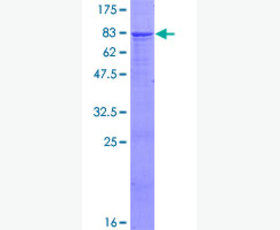Recombinant Human Bcl-2 Related Protein A1/BCL2A1
| Product name: | Recombinant Human Bcl-2 Related Protein A1/BCL2A1 |
| Source: | E.coli |
| Purity: | Greater than 95% as determined by reducing SDS-PAGE. |
| Buffer Formulation: | Supplied as a 0.2 μm filtered solution of 20mM PB, 150mM NaCl, 1mM EDTA, 1mM DTT, 10% Glycerol, pH 7.4. |
| Applications: | Applications:SDS-PAGE; WB; ELISA; IP. |
| Storage: | Avoid repeated freeze/thaw cycles. Store at 2-8 oC for one month. Aliquot and store at -80 oC for 12 months. |
| UOM: | 100ug/50ug/200ug/1mg/1g |
| Source | E.coli |
| Description | Recombinant Human Bcl-2 Related Protein A1 is produced by our E.coli expression system and the target gene encoding Met1-Ser152 is expressed with a 6His tag at the C-terminus. |
| Names | Bcl-2-Related Protein A1, Bcl-2-Like Protein 5, Bcl2-L-5, Hemopoietic-Specific Early Response Protein, Protein BFL-1, Protein GRS, BCL2A1, BCL2L5, BFL1, GRS, HBPA1 |
| Accession # | Q16548 |
| Formulation | Supplied as a 0.2 μm filtered solution of 20mM PB, 150mM NaCl, 1mM EDTA, 1mM DTT, 10% Glycerol, pH 7.4. |
| Shipping |
The product is shipped on dry ice/ice packs. |
| Storage |
Store at < -20°C, stable for 6 months after receipt. Please minimize freeze-thaw cycles. |
| Purity |
Greater than 95% as determined by reducing SDS-PAGE. |
| Endotoxin | Less than 0.1 ng/µg (1 IEU/µg) as determined by LAL test. |
| Amino Acid Sequence |
MTDCEFGYIYRLAQDYLQCVLQIPQPGSGPSKTSRVLQNVAFSVQKEVEKNLKSCLDNVNVVSVD TARTLFNQVMEKEFEDGIINWGRIVTIFAFEGILIKKLLRQQIAPDVDTYKEISYFVAEFIMNNT GEWIRQNGGWENGFVKKFEPKSLEHHHHHH
|
| Background | Bcl-2-Related Protein A1 (BCL2A1) is a member of of the BCL-2 protein family which act as anti- and pro-apoptotic regulators that are involved in a wide variety of cellular activities such as embryonic development, homeostasis and tumorigenesis. BCL2A1 is a cytoplasm protein and interacts directly with BAK1, BID, BMF and BBC3. BCL2A1 is induced by phorbol ester and inflammatory cytokines, such as TNF or IL1B/interleukin-1 beta, but not by growth factors. BCL2A1 is invovled in the response of hemopoietic cells to external signals and in maintaining endothelial survival during infection. |














